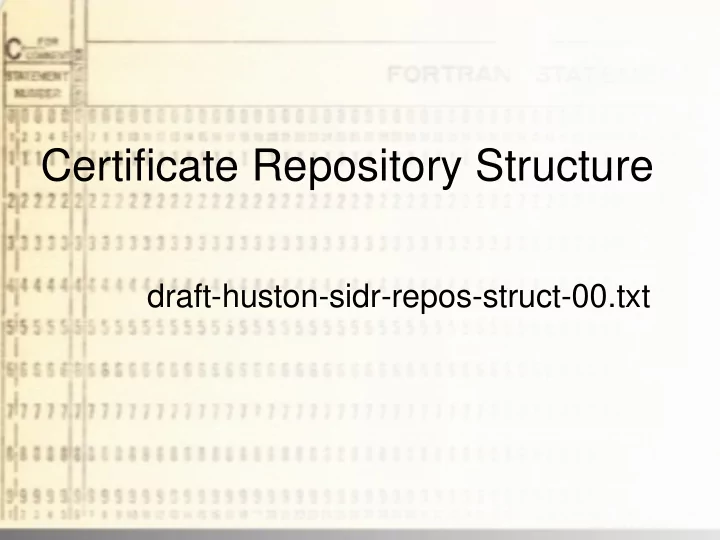

Certificate Repository Structure draft-huston-sidr-repos-struct-00.txt
Basic Model ● 'named objects make other named objects' – Natural parent-child relationship in process ● Follow the hierarchy – Nodes (ie directories) and Objects (files) – Information management advantages ● Local sub-trees can be independently managed ● ‘what made me’ & ‘what do I make’ easy to find/combine into global information base ● Use g(AKI) and g(SKI) for names, CRL, '*IA' – Algorithmic naming, not real-entity. Tied to public key of certificate ● (very low) risk of hash collision ● Avoids ‘real world name’ politics
Hierarchy model ● Rooted at each Trust Anchor (TA) – Trust anchor self signed – In repository name model, AKI == SKI – (don’t just trust self-signed or AKI==SKI, TA must be externally defined to be valid) ● For each certificate issued – Sub-dir at ‘node level’ (for products of certificate) named by SKI of certificate. Sub-dir contents: ● produced certs, CRL (for CA certs) ● Signed objects (for EE certs) – Name structure stable across certificate re-issuance ● if public key remains constant.
Trust Anchors (self-reference) Canonical file name: pvpjvwUeQix2e54X8fGbhmdYMo0-2F.cer serial: 2F g(AKI): pvpjvwUeQix2e54X8fGbhmdYMo0 g(SKI): pvpjvwUeQix2e54X8fGbhmdYMo0 CRLdp: rsync://repository.apnic.net/APNIC/ pvpjvwUeQix2e54X8fGbhmdYMo0/ Trust Anchor pvpjvwUeQix2e54X8fGbhmdYMo0.crl Ipv4 10.0.0.0/8 AIA: rsync://repository.apnic.net/APNIC/ 192.168.0.0/16 pvpjvwUeQix2e54X8fGbhmdYMo0 SIA: rsync://repository.apnic.net/APNIC/ pvpjvwUeQix2e54X8fGbhmdYMo0
Products of TA Canonical file name: DLAl5E2IJgSdp2syO9gvEeptpsI-51.cer serial: 51 g(AKI): pvpjvwUeQix2e54X8fGbhmdYMo0 g(SKI): DLAl5E2IJgSdp2syO9gvEeptpsI CRLdp: rsync://repository.apnic.net/APNIC/ pvpjvwUeQix2e54X8fGbhmdYMo0/ Cert made by TA DLAl5E2IJgSdp2syO9gvEeptpsI/ DLAl5E2IJgSdp2syO9gvEeptpsI.crl Ipv4 10.0.0.0/8 192.168.0.0/16 AIA: rsync://repository.apnic.net/APNIC/ pvpjvwUeQix2e54X8fGbhmdYMo0 SIA: rsync://repository.apnic.net/APNIC/ pvpjvwUeQix2e54X8fGbhmdYMo0/ DLAl5E2IJgSdp2syO9gvEeptpsI
Products of (products of TA) Canonical file name: zGJyRYzO3n7rcGV_hH-Hmn68OPY-505 .cer serial: 505 g(AKI): DLAl5E2IJgSdp2syO9gvEeptpsI g(SKI): zGJyRYzO3n7rcGV_hH-Hmn68OPY CRLdp: rsync://repository.apnic.net/APNIC/ Cert made pvpjvwUeQix2e54X8fGbhmdYMo0/ by Cert, DLAl5E2IJgSdp2syO9gvEeptpsI/ made by TA zGJyRYzO3n7rcGV_hH-Hmn68OPY/ zGJyRYzO3n7rcGV_hH-Hmn68OPY.crl Ipv4 10.0.0.0/8 AIA: rsync://repository.apnic.net/APNIC/ pvpjvwUeQix2e54X8fGbhmdYMo0/ DLAl5E2IJgSdp2syO9gvEeptpsI SIA: rsync://repository.apnic.net/APNIC/ pvpjvwUeQix2e54X8fGbhmdYMo0/ DLAl5E2IJgSdp2syO9gvEeptpsI zGJyRYzO3n7rcGV_hH-Hmn68OPY
path discovery to TA g(AKI): AAAA TA is defined: g(SKI): AAAA terminate. crldp: URI-A/AAAA.crl TA AIA: URI-A/ SIA: URI-A/ g(AKI): AAAA g(SKI): BBBB Cert, crldp: URI-A/BBBB/BBBB.crl made by TA AIA: URI-A/ SIA: URI-A/BBBB g(AKI): BBBB Cert made g(SKI): CCCC by Cert, crldp: URI-A/BBBB/CCCC/CCCC.crl made by TA AIA: URI-A/BBBB/ SIA: URI-A/BBBB/CCCC
Object-Name model For a CA ● – Your parent’s SKI became your AKI. – Your SKI becomes your children’s AKI Sha1 hash over ASN.1 of public key ● – Extremely low collision risk – g(ski) or g(aki)+<serial> unique for any given CA – g(ski) alone: all re-issues with same public key hash to same location (serials not involved) ● No name change with normal certificate renewal – Public key change == complete namespace rollover (unavoidable) Represented by ‘url friendly’ modified base64 ● representation, <64 chars per cert instance
Hierarchy Implications ● Inter-RIR registration/transfers explicit in repository certificate, naming model ● Clean separation of address-types in hierarchy – Experimental separated from Historical from Current RIR policy from … ● Clean model for independent sub-trees – Provide publication point in RSYNC: URL space – Irrespective of local naming policy, cert identity in repository is deterministic – No risk of collision when uploaded into global repository structure
Modified-Gutmann Alg: g(ski) Use of base64 Specified in rfc4387 ● – Reduces 160-bit sha1 to 27 char Base64 encoding. ● URLs not workable in filestore contexts due to presence of ‘/’ character. ● ‘+’ character interfered with URL parsing I-D.josefsson-rfc3548bis ● – Base64 transform, ‘/’ and ‘+’ replaced by ‘-’ and ‘_’ ● No size increase, URL friendly, filestore friendly – Can be implemented as a post-process on Base64 transform, or as a native function Resulting object names are at least 26 chars long ● – Plus serial (up to 20 chars of HEX) plus syntactic sugar for filename.ext purposes) – Under 64-char limits for older FS (but clearly over 8.3) – Not ‘mandatory' to implement as dir/file store, but useful
Why not certificate names? These are not identity certs ● – No applicability in browsers, webservers, email signing – Identity checks for issuance still required but now local to issuer, no global context ● Unless driven by other needs – Can use ‘shadow cert’ process to derive certificates with apparent name for business purposes Avoids any consideration of entity name collision ● – in certificate namespace, encodings, field choices – directory name model is inherently complex Survivable across future models of address transfer/trading ● “it’s the crypto, not the name which secures” ● – Proof of knowledge of private key authorizes signed outcomes, not the name on the certificate in this model
Operations models ● Authenticated copy – TA must be sourced out-of-band. – Fetch repository via rsync ● Crl from CRLdp of TA ● Repository contents via AIA of TA – Top-down walk to validate all objects published at TA ● Recurse for independent SIA/CRLdp ● Local sub-repository – Requires at LEAST path back to issuing TA to perform validation
Why Rsync? ● Avoid inventing new protocol ● Desireable features – Can fetch single objects, trees – Byte efficient (only differing blocks) – No fetch of unchanged objects ● Downsides – May be expensive on server – Lax formal specification
What do we get? ● Deterministic, simple naming ● Objects always have a known place in hierarchy ● EE certs, CRLs, 'products' nest cleanly inside 'producer' namespace ● Clean separation of certs by delegation (right back to TA == 'root')
Natural hierarchies form TA1 prod(TA1) prod(TA1) prod(TA1) p(p(TA1)) CRL p(p(TA1)) ee(p(p(TA1))) roa(a) roa(b) roa(c)
...but you inherit multiple TA ISP-A
Recommend
More recommend